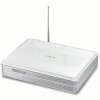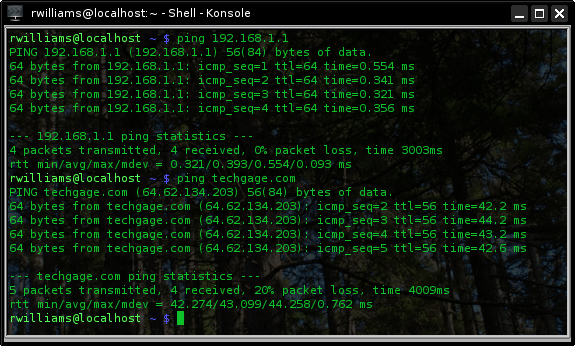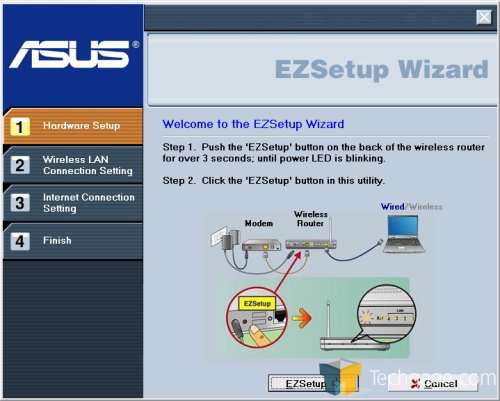- Qualcomm Launches Snapdragon 4 Gen 2 Mobile Platform
- AMD Launches Ryzen PRO 7000 Series Mobile & Desktop Platform
- Intel Launches Sleek Single-Slot Arc Pro A60 Workstation Graphics Card
- NVIDIA Announces Latest Ada Lovelace Additions: GeForce RTX 4060 Ti & RTX 4060
- Maxon Redshift With AMD Radeon GPU Rendering Support Now Available
ASUS WL-500g Premium Router

Routers are often boring, but ASUS proves that doesn’t have to be the case. The WL-500g is a very fast WiFi router that offers USB connectivity and even the ability to download while your computer is turned off!
Page 2 – Installation
|
|
I won’t provide a huge quantity of images of the admin, because it’s not much to look at. However, upon first entry, you will be asked, “Thanks for purchasing the ASUS Wireless Router, do you like to start Quick Setup directly?”, to which I promptly said yes. Well, the computer didn’t understand me when I talked to it, so I instead clicked on the OK button.
Here in order, are the questions you are prompted with:
- 1) Time Zone
- 2) Connection Type – Cable Modem or ADSL… and/or PPPoE.
- 3) Hostname information – In case your ISP requires it.
- 4) WAN IP Setting – Simple options you will not need to touch if your connection is automatically configured.
- 5) Wireless Interface – Here, you can set up your SSID, security and key index. WPA/WPA2/WEP/WPA-PSK… et cetera, are all available.
- 6) Done! At this point, the router simply reboots and you should be good to roll.
My configuration is this: 2 PC’s wired into the router, 1 Xbox wired, 2 PC’s wireless into the router. At first, the wired connections worked no problem, but the Wireless was completely non-functional.
This is not something that surprised me though, as I’ve always run into problems in the past. Personally, I blame them on the D-Link NIC’s I am using, but I can’t point the blame until I get another network card in to test with. Regardless, the WiFi ended up working on the PC with a PCI-Wifi card, but not the one with the USB based WiFi card. With security completely turned off, I could connect to the router without issue from the PC with the actual network card, but not the other. Again, I blame this on the adapter, as it’s complete garbage. Something I should not have wasted money on, back in the day.
I tested out WPA/WPA2 and the PSK varients, but got absolutely nowhere. So at this point, I figured I’d throw in the CD-Rom to see if it would help me along any. At this time, I was unaware that any software was included on the disc, but there is a simple utility called “EZSetup Wizard”.
This begins you out at a screen showing you a diagram of how your setup should be. Then, you must reset the router and hold the EZ Setup button for three seconds. After, you can push the respective button in the program to continue.
If all is setup properly, the program will scan for the router and then if successful, connect to it. You are required to input an SSID, and it will automatically supply a WEP key for you. If you prefer WPA, the option is there for that also. I stuck with WEP for the sake of simpleness. It then finalizes the configuration. Lo and behold, the internet worked like a dream!
I took the key it provided and brought it to the other computer, configured the WiFi in Windows, and then that PC was also working on the network without issue. When it comes to networks, all experiences may prove different. I am the kind of person who will run into a hundred varying problems first, just because that’s how things have to be. After the EZ Setup set everything.. up, I manually inputted all the values inside the router and had the same results. I am a networking noob, but it didn’t take very long to get everything set up properly.
The first thing I wanted to give a test was the latency. The first test was on a Windows machine about 20ft away from the router. Throughout multiple tests, the latency hovered between 1 – 4ms. Pinging the website proved to be speedy also, though that’s lag that has nothing to do really with the router. The website is half a continent away from my house, so 45ms is not too shabby.

Using a wired connection, we can see the latency is even better improved. Nothing incredible here, as this is really the norm nowadays. However, it’s better it be the “norm” than be worse off ;-)

I tested the connections throughout the day, and repeatedly tested for variations in the latencies. Even while downloading a huge ISO at high speeds, the latency didn’t increase, which was nice to see. So, online gaming should not prove to be a problem at -all-. The latencies were very low, and the highest I have seen them go was 4ms… still respectable. This is essentially 4ms more than what a wired connection would provide, but in the end there is no noticeable difference when doing anything online between the two computers.
|
|
Support our efforts! With ad revenue at an all-time low for written websites, we're relying more than ever on reader support to help us continue putting so much effort into this type of content. You can support us by becoming a Patron, or by using our Amazon shopping affiliate links listed through our articles. Thanks for your support!







